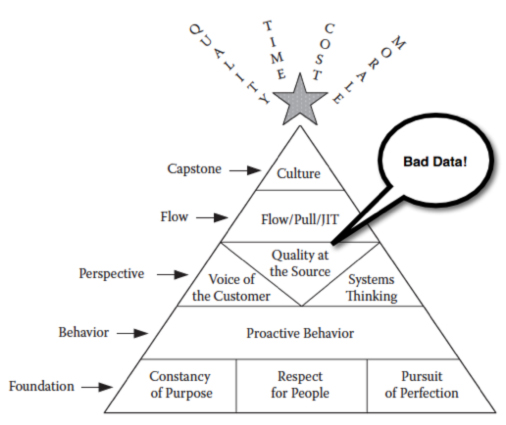Everyone can agree on the importance and impact of quality information to any business. Still, it’s a topic that few people are excited to discuss. How can this be?
Bad data isn’t exactly the most exciting topic to explore. Plus, it’s somewhat of a black box for many people. If you ask, “Who is responsible for the quality of the information in our IT systems, work processes, and the components of our Lean Management System?” you usually hear “Everyone!” in reply. That may be true, but it’s not particularly helpful because if everyone is collectively responsible, no one is individually accountable! Data quality is like a pop up fly ball that drops to the ground between two highly paid professional baseball player; each assumes the other has responsibility to catch it.
Within the context of Lean, if you are populating your systems with bad data, then it really doesn’t matter how well you have developed and standardized work processes to fulfill core capabilities aligned to fulfill your organization’s purpose. Why? Your people do not have the information they need to make informed, accurate, and timely decisions to do the right work, the right way, the first time, every time. You are essentially sentencing the organization to an endless cycle of unplanned work, interruptions, and rework!
When technology efficiently delivers bad information, it serves to enable waste, delays, and poor results. We set people up to make more mistakes, create more rework and workarounds, make more guesses, and ultimately contend with more non-value added work. This creates more work, overburden, and stress as well as intensifying variability of quality, time, and productivity. All the more reason to talk about it!
The goal of IT is to enable people to perform their jobs well by providing access to complete and accurate information so they can work as effectively and efficiently as possible. From a lean IT perspective, we leverage technology to position people to do great work with the least amount of required effort. Technology has the capability to gather, store, organize, manipulate, calculate, analyze, format, and report limitless amounts of data in order to create actionable information.
People are smart and usually know when the information they are receiving is not right, but not always. People are creative and when they determine they are getting inaccurate or incomplete information, they resort to a variety of workarounds including experience-based gut feel decisions, making and acting on assumptions, or simply guessing. Some develop rules of thumb based on personal knowledge, while others devise creative workarounds to obtain the information they require when system information is suspect and unreliable. Unfortunately none of these countermeasures confronts the root cause of the problem, nor guarantees a timely and accurate business outcome.
Bad data generates bad information, prompting people to make misinformed decisions, mistakes, oversights, and the creation of more bad data! The compounding impact of inaction-able information is a frustrating, downward cycle of errors that force people to resort to heroic efforts to deliver mediocre results.
Customers instantly notice a lack of service, timeliness, and quality. As employees become more aware of data problems, they begin to lose trust in the system and resort to the creative workarounds, which may feel better and attain some results, but do not materially improve the situation. In fact, the more exceptions and workarounds to the way work is conducted, the more variability the customer experiences in service levels, quality, and delivery time!
How Lean IT Can Help
Lean IT is a framework for deeply understanding information, communication and technology in a new light through applying the principles and methods of lean. information. It’s about enabling flow. If there is a chronic lack of high-quality information, it’s impossible to sustain a smooth flow of work because fixing mistakes channels precious energy and mental capacity from your employees.

The image above (from my book Lean IT) shows a principles pyramid you can use to get a handle on how to think about IT. At its core, lean IT is about leveraging technology to make people’s work easier to create and deliver customer value. We remove all unnecessary effort – ambiguity of process, avoidable mistakes, self-inflicted variation, corrections, rework, delays, and extra steps. For the purpose of this discussion, let’s focus on the principle of Quality at the Source.
Quality at the source means performing work right the first time, every time: imperfect work (work that is incomplete or inaccurate) is never passed on to the next operation, end users, or customers. We measure quality in terms of percentage of work that is accurate, complete, timely, and accessible (as defined by end users and customers) the first time we do the work. The critical nature of the quality of information is well-known. We’re all familiar with the truism “Garbage in, garbage out!” Without quality information, the results will always be inferior and require heroic efforts and creative rework to meet customer expectations.
For quality information, you need quality data. Most organizations focus the majority of their effort and resources on technology while paying little attention to the quality of data within the system – the thing that really matters. You can have state-of-the-art hardware technology, but if you have data issues, the result is in-actionable information received by end users, confusion, frustration, errors, workarounds, and pain as a result. This wasteful non-value added effort and annoyance only gets worse over time because once people no longer trust the system, they adapt skillfully to perform their job outside of the system to get their work done!
What can you do to address data quality problems, reduce the non-value added work, and leverage lean IT to create greater value?
1) Connect: Engage with your employees by going to where the work is done to better understand the challenges they are experiencing and to see things from their perspective.
2) Involve: Introduce lean process improvements by applying the PDCA cycle of experimentation.
3) Automate: Only after you engage your people and improve core work processes should you consider new technology and/or reconfiguration to automate and streamline newly improved processes.
It’s all about engaging people, improving processes, and leveraging technology –in that order. The sooner you begin to address the issue of data quality, the sooner you realize the impact of high-quality actionable information.
Learn more with Lean IT, Enabling and Sustaining Your Lean Transformation, and by pre-ordering the “how to” book The Lean IT Field Guide (available November 2015).






